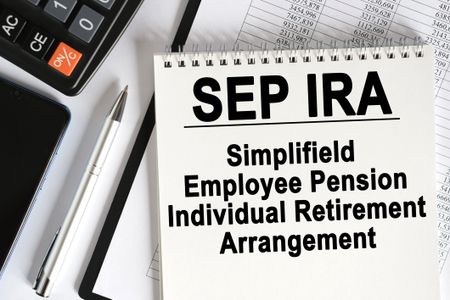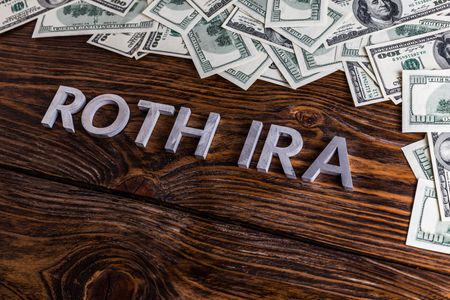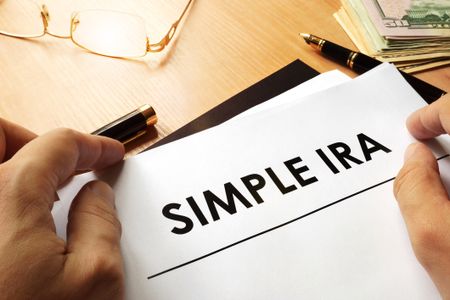Tax Planning for Retirement
Taxes don’t stop when your paycheck does. In fact, tapping your retirement nest egg comes with all sorts of new rules and opportunities.
When you retire, your life changes in many ways — and so do your finances. One of the biggest changes is that instead of contributing to tax-deferred retirement savings plans that reduce your taxes, you'll start tapping those savings for income and paying taxes at your regular rate (unless you’re tapping a Roth account) — not the preferential capital-gains rate reserved for stocks and bonds held in taxable accounts.
What to Do with Your 401(k)
One of the first decisions you'll have to make is what to do with the savings you have accumulated in your 401(k) or similar workplace-based retirement plan. As long as you have a balance of $5,000 or more, you can keep it with your former employer until the plan’s normal retirement age (often 65) or, in some cases, until you reach age 70 1/2. You might want to do that if you like the investment choices and the low fees of your employer's plan.
And if you are at least 55 by the end of the year in which you leave your job, you can start tapping your 401(k) funds penalty free — although you'll still owe income taxes on your withdrawals. If you roll the money over to an IRA, where you will have more investment choices, you must be at least 59½ to avoid early withdrawal penalties when taking money out of the account.

Sign up for Kiplinger’s Free E-Newsletters
Profit and prosper with the best of expert advice on investing, taxes, retirement, personal finance and more - straight to your e-mail.
Profit and prosper with the best of expert advice - straight to your e-mail.
Rollover to a Traditional IRA
If you decide to roll over some or all of your 401(k) money to an IRA, you can preserve your tax deferral by transferring the funds directly to the new custodian, such as a broker, mutual fund or life insurance company.
Don't make the mistake of having a check made out to you. If you do, your employer will be required to withhold 20% of the balance for taxes even if you plan to complete a rollover to an IRA within 60 days. Any money that's not in an IRA within that time period — including any part of that 20% withheld from the IRS that you aren't able to come up with elsewhere — will be treated as a distribution and subject to income taxes plus a 10% penalty if you are younger than 55. You avoid this potential problem by having the money sent directly to your IRA or having the check written to your IRA account.
Company Stock
If you own highly appreciated company stock, special rules for what's called net unrealized appreciation (NUA) can result in significant tax savings. When you take a lump-sum distribution from your 401(k), you can move the stock to a taxable account and roll over the rest of the assets to an IRA. You'll pay ordinary income taxes on your basis (what you paid for the stock), but the remaining NUA (the appreciation while the stock was in your retirement plan) will be taxed only when the stock is sold.
And, here's the kicker: At that point, the profit will qualify for the favorable long-term capital-gain rate. In contrast, if you roll over your entire balance to an IRA, all of your withdrawals, including that which comes from the profit on your company stock, will be taxed at your top tax rate. This pays off best for company stock that has appreciated smartly inside your 401(k).
Mandatory Distributions
Tax-deferrals on retirement savings don't last forever. You must start taking taxable withdrawals from your traditional IRA or 401(k) by the April 1 following the year you turn 70½. Subsequent annual withdrawals are due by December 31 of each year. Each year’s required minimum distribution (RMD) is based on your account balance at the end of the previous year divided by a life expectancy factor set by the IRS.
If you don't take your full RMD each year, there's a stiff penalty — 50% of the amount you failed to withdraw. You can always take out more than the minimum required amount and pay taxes at your regular rate on all the withdrawals. You can ask your retirement account custodian to withhold taxes from your distributions, or you can file quarterly estimated tax payments. (For more, see 10 Things Boomers Must Know About RMDs.)
Roth IRAs
There is a great deal of confusion about how withdrawals from Roth IRAs are taxed. There’s a widespread belief, for example, that money comes out of a Roth tax free only after age 59 ½ and then only if the account has been open for at least five years.
It is true that to withdraw earnings from a Roth tax-free, you must be at least 59 ½ and the account must have been opened for at least five years. But earnings are the last thing to come out of a Roth. The IRS assumes that the first money withdrawn comes from any annual contributions you made (and this money can be tapped tax- and penalty-free at any time). Next, you dip into funds that went into the Roth via a conversion from a traditional IRA or 401(k) and these amounts are always tax-free, and penalty-free, too, if you are over age 59 ½ or the account has been open for at least five years. Only after you retrieve all of your contributions and converted amounts do you touch earnings . . . and if at least five years have passed and you’re over age 59 ½, the earnings are tax- and penalty-free.
So, if you convert $100,000 today, you can withdraw it all tomorrow tax-free (but not penalty-free unless you’re at least 59 ½). Unlike traditional IRAs, there are no mandatory distribution rules with Roth IRAs, so you never have to touch the money if you don't need it, allowing the money to grow tax-free for years. Your heirs will thank you because they, too, can take distributions from an inherited Roth IRA tax-free. (Money in an inherited traditional IRA is taxed in the heir's top tax bracket.)
Roth 401(k) Plans
If you contribute to the latest innovation in retirement savings — the Roth 401(k) — you can also benefit from tax-free distributions once you're 59½. But the Roth 401(k) does have mandatory distribution rules, like traditional 401(k) plans, starting at 70½. It's easy to get around that, though. Simply roll over the Roth 401(k) portion of the account to a Roth IRA when you retire. There will be no tax consequences, and you never have to tap the account.
Convert to a Roth
Anyone can convert a traditional IRA or 401(k) to a Roth IRA to enjoy tax-free withdrawals in retirement. The rule that used to ban such conversions if your adjusted gross income was more than $100,000 has been abolished. There’s a high price of admission to a Roth, however. You must pay tax on any as yet untaxed money that you convert — and for most taxpayers that means 100% of the converted amount.
[page break]
Social Security
Another big decision is when to start taking your Social Security benefits. You can start as early as 62, but your retirement benefits will be reduced by 25% or more for the rest of your life. Or you can wait to collect your full benefits when you reach your normal retirement age, which is 66 for those born between 1943 and 1954. Or you can wait longer. For each year you delay collecting benefits after your normal retirement date up until age 70, you qualify for an even bigger retirement benefit. Delayed-retirement credits add 8% a year to your benefit, so your benefit at age 70 would be 32% higher than what you’d get if you claim benefits at age 66. As you consider when to take your Social Security, factor in how your benefits will be taxed.
Also, consider whether you plan to continue working once you start collecting Social Security benefits. If you are younger than your normal retirement age, you will lose $1 in retirement benefits for every $2 you earn over the earnings cap, which is $16,920 for 2017. There’s a more generous limit for the year you reach normal retirement age and there is no restriction after you reach age 66.
A portion of your benefits may be taxed depending on your income which, for this test, includes your adjusted gross income, plus any tax-free interest income, plus half of your Social Security benefits. If your income is less than $25,000 on a single return or $32,000 on a joint return, your Social Security benefits are tax-free.
Individuals with incomes between $25,000 and $34,000 pay tax on up to 50% of their benefits. Individuals with incomes over $34,000 pay income tax on up to 85% of their benefits. Married couples filing a joint return with incomes between $32,000 and $44,000 pay tax on up to 50% of their Social Security retirement benefits. Those couples with incomes over $44,000 pay taxes on up to 85% of their benefits.
You can ask the Social Security Administration to withhold federal income taxes from your retirement benefits, or you can pay quarterly estimated taxes. To start, stop or change your withholding, file a form W-4V with your local Social Security Administration office. State tax laws vary. Some state exempt some or all of Social Security benefits from income taxes.
Pensions
Pension and annuity payments from employer-sponsored retirement plans are fully taxable. You can elect to have federal income taxes withheld from your pension or annuity check, or you can file quarterly estimated tax payments. State tax laws vary. Some exempt certain types of pensions, such as military or government pensions, from state income taxes. Others allow a portion of any type of pension income to escape state income taxes. A few fully tax pension income. You should get a Form 1099-R from the payer each year showing how much taxable income you received.
Annuities
If you purchase an annuity with non-qualified funds (money not inside a retirement account), the payments you receive will be partially tax free. The portion of each payment that represents a return of your investment is tax-free; the portion that represents investment earnings is taxable. Again, you should receive a 1099-R from the insurance company showing the taxable amount.
Health Savings Accounts
Any distribution from an HSA used to pay for medical expenses is tax free. Once you reach 65, HSA distributions used to pay for non-medical expenses are subject to income taxes but avoid the 20% penalty that applies to those under age 65 who use the money for non-medical reasons.
Get Kiplinger Today newsletter — free
Profit and prosper with the best of Kiplinger's advice on investing, taxes, retirement, personal finance and much more. Delivered daily. Enter your email in the box and click Sign Me Up.
-
 Microsoft Stock: Innovation Spurs Its 100,000% Return
Microsoft Stock: Innovation Spurs Its 100,000% ReturnMicrosoft's ability to recognize the "next big thing" has allowed sales – and its share price – to grow exponentially over the years.
By Louis Navellier Published
-
 6 Great Vacation Ideas for Wheelchair Users
6 Great Vacation Ideas for Wheelchair UsersThese six places provide plenty of travel inspiration for people who use wheelchairs.
By Becca van Sambeck Published
-
 What Does Medicare Not Cover? Eight Things You Should Know
What Does Medicare Not Cover? Eight Things You Should KnowHealthy Living on a Budget Medicare Part A and Part B leave gaps in your healthcare coverage. But Medicare Advantage has problems, too.
By Donna LeValley Published
-
 457 Plan Contribution Limits for 2025
457 Plan Contribution Limits for 2025Retirement plans There are higher 457 plan contribution limits for state and local government workers in 2025. That's good news for state and local government employees
By Kathryn Pomroy Last updated
-
 Medicare Basics: 11 Things You Need to Know
Medicare Basics: 11 Things You Need to KnowMedicare There's Medicare Part A, Part B, Part D, Medigap plans, Medicare Advantage plans and so on. We sort out the confusion about signing up for Medicare — and much more.
By Catherine Siskos Last updated
-
 The Seven Worst Assets to Leave Your Kids or Grandkids
The Seven Worst Assets to Leave Your Kids or Grandkidsinheritance Leaving these assets to your loved ones may be more trouble than it’s worth. Here's how to avoid adding to their grief after you're gone.
By David Rodeck Last updated
-
 SEP IRA Contribution Limits for 2025
SEP IRA Contribution Limits for 2025SEP IRA A good option for small business owners, SEP IRAs allow individual annual contributions of as much as $69,000 in 2024 and $70,000 in 2025..
By Jackie Stewart Last updated
-
 Roth IRA Contribution Limits for 2025
Roth IRA Contribution Limits for 2025Roth IRAs Roth IRA contribution limits have gone up. Here's what you need to know.
By Jackie Stewart Last updated
-
 SIMPLE IRA Contribution Limits for 2025
SIMPLE IRA Contribution Limits for 2025simple IRA The SIMPLE IRA contribution limit increased by $500 for 2025. Workers at small businesses can contribute up to $16,500 or $20,000 if 50 or over and $21,750 if 60-63.
By Jackie Stewart Last updated
-
 457 Contribution Limits for 2024
457 Contribution Limits for 2024retirement plans State and local government workers can contribute more to their 457 plans in 2024 than in 2023.
By Jackie Stewart Published